Managing & Running a Small Business: Resource, CRM, Finance & Law
VerifiedAdded on 2024/06/04
|25
|5442
|211
Report
AI Summary
This report provides a comprehensive analysis of managing and running a small business, focusing on key considerations such as resource allocation, customer relationship management (CRM), financial analysis, and legal compliance. It begins by discussing the essential resources needed for a small business, emphasizing the importance of workforce, support systems, and capital. The report then delves into resource allocation techniques, highlighting GlaxoSmithKline as a case study, and assesses the significance of planning and allocating resources to achieve business objectives. It evaluates different CRM processes, explaining how small businesses can develop transnationally, weighing the benefits and drawbacks of such expansion. Furthermore, the report includes an annual itemized monthly cash flow forecast, break-even analysis, and interpretation of key financial statements. Finally, it discusses the key legislation and regulations impacting small businesses, providing a critical evaluation of their implications and considering future developments. This document is available on Desklib, a platform offering a range of study tools and resources for students.
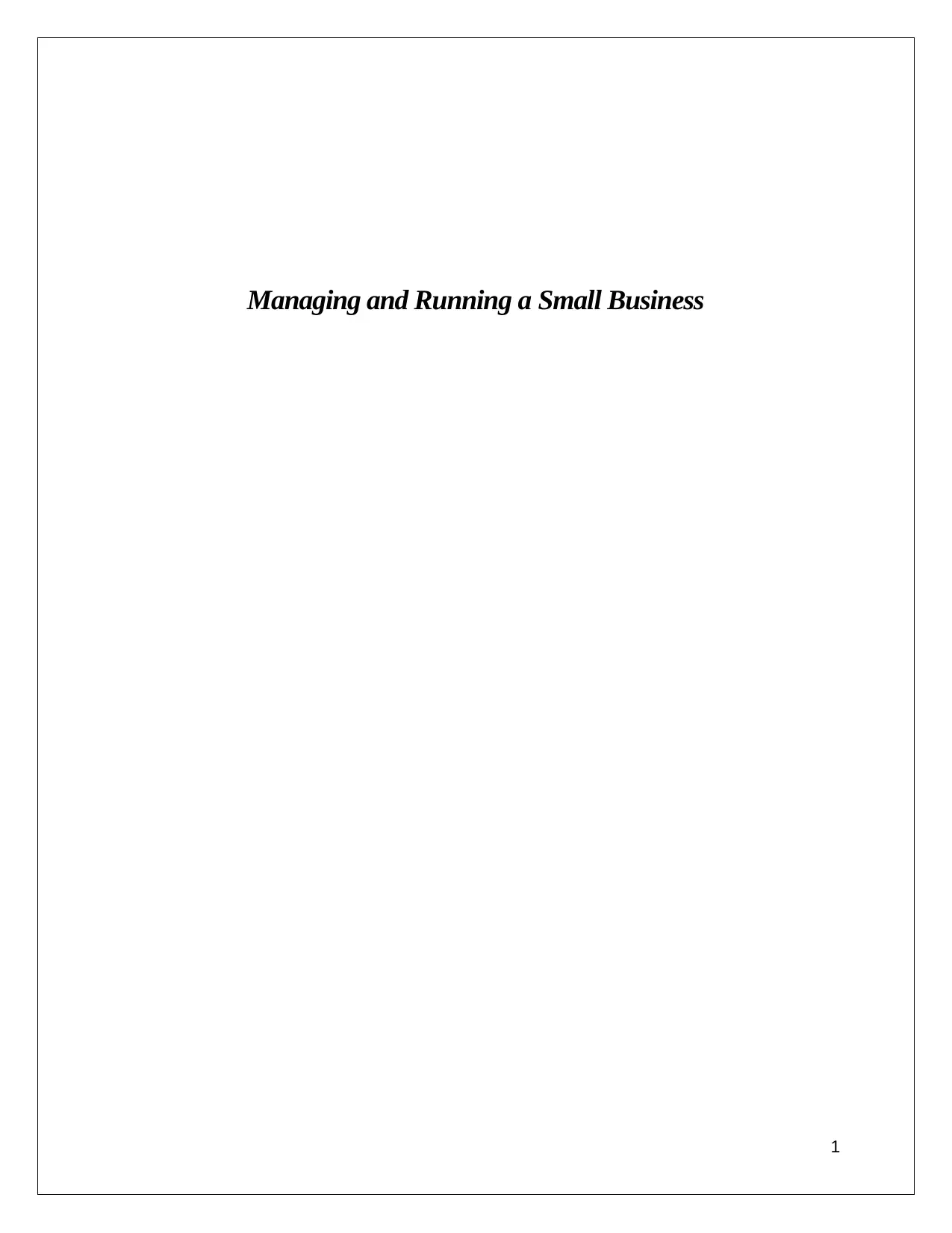
Managing and Running a Small Business
1
1
Paraphrase This Document
Need a fresh take? Get an instant paraphrase of this document with our AI Paraphraser
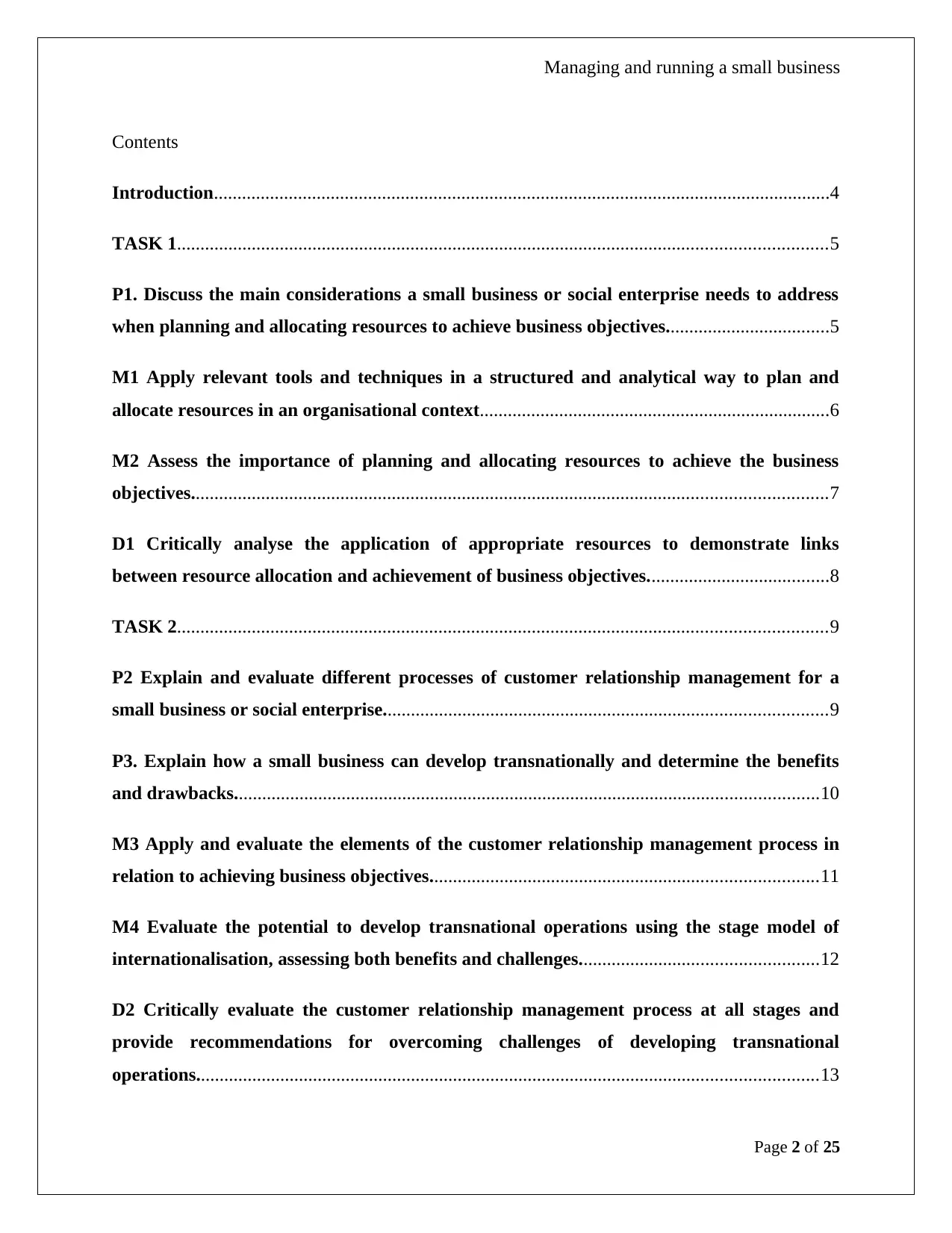
Managing and running a small business
Contents
Introduction....................................................................................................................................4
TASK 1...........................................................................................................................................5
P1. Discuss the main considerations a small business or social enterprise needs to address
when planning and allocating resources to achieve business objectives...................................5
M1 Apply relevant tools and techniques in a structured and analytical way to plan and
allocate resources in an organisational context...........................................................................6
M2 Assess the importance of planning and allocating resources to achieve the business
objectives........................................................................................................................................7
D1 Critically analyse the application of appropriate resources to demonstrate links
between resource allocation and achievement of business objectives.......................................8
TASK 2...........................................................................................................................................9
P2 Explain and evaluate different processes of customer relationship management for a
small business or social enterprise...............................................................................................9
P3. Explain how a small business can develop transnationally and determine the benefits
and drawbacks.............................................................................................................................10
M3 Apply and evaluate the elements of the customer relationship management process in
relation to achieving business objectives...................................................................................11
M4 Evaluate the potential to develop transnational operations using the stage model of
internationalisation, assessing both benefits and challenges...................................................12
D2 Critically evaluate the customer relationship management process at all stages and
provide recommendations for overcoming challenges of developing transnational
operations.....................................................................................................................................13
Page 2 of 25
Contents
Introduction....................................................................................................................................4
TASK 1...........................................................................................................................................5
P1. Discuss the main considerations a small business or social enterprise needs to address
when planning and allocating resources to achieve business objectives...................................5
M1 Apply relevant tools and techniques in a structured and analytical way to plan and
allocate resources in an organisational context...........................................................................6
M2 Assess the importance of planning and allocating resources to achieve the business
objectives........................................................................................................................................7
D1 Critically analyse the application of appropriate resources to demonstrate links
between resource allocation and achievement of business objectives.......................................8
TASK 2...........................................................................................................................................9
P2 Explain and evaluate different processes of customer relationship management for a
small business or social enterprise...............................................................................................9
P3. Explain how a small business can develop transnationally and determine the benefits
and drawbacks.............................................................................................................................10
M3 Apply and evaluate the elements of the customer relationship management process in
relation to achieving business objectives...................................................................................11
M4 Evaluate the potential to develop transnational operations using the stage model of
internationalisation, assessing both benefits and challenges...................................................12
D2 Critically evaluate the customer relationship management process at all stages and
provide recommendations for overcoming challenges of developing transnational
operations.....................................................................................................................................13
Page 2 of 25
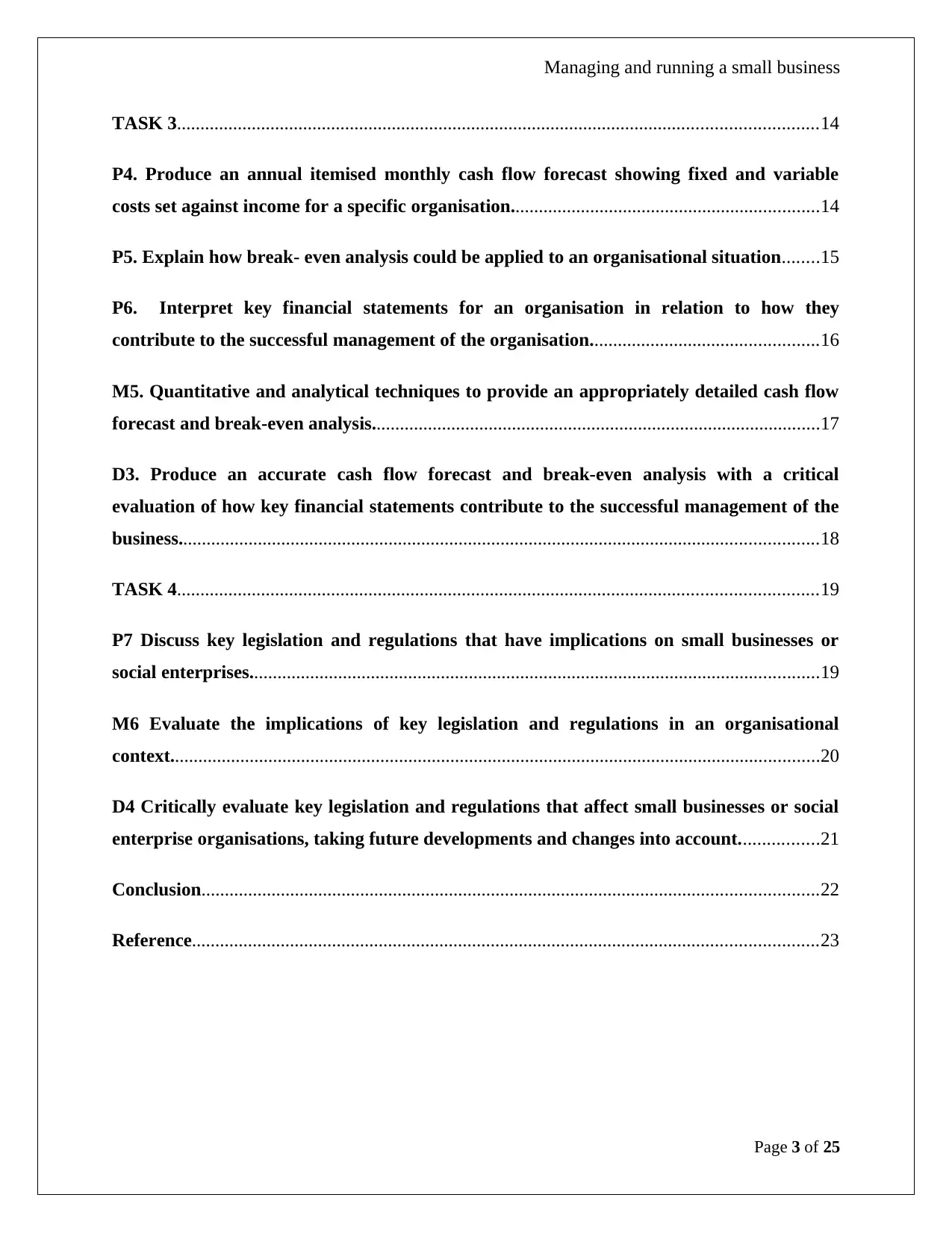
Managing and running a small business
TASK 3.........................................................................................................................................14
P4. Produce an annual itemised monthly cash flow forecast showing fixed and variable
costs set against income for a specific organisation..................................................................14
P5. Explain how break- even analysis could be applied to an organisational situation........15
P6. Interpret key financial statements for an organisation in relation to how they
contribute to the successful management of the organisation.................................................16
M5. Quantitative and analytical techniques to provide an appropriately detailed cash flow
forecast and break-even analysis................................................................................................17
D3. Produce an accurate cash flow forecast and break-even analysis with a critical
evaluation of how key financial statements contribute to the successful management of the
business.........................................................................................................................................18
TASK 4.........................................................................................................................................19
P7 Discuss key legislation and regulations that have implications on small businesses or
social enterprises..........................................................................................................................19
M6 Evaluate the implications of key legislation and regulations in an organisational
context...........................................................................................................................................20
D4 Critically evaluate key legislation and regulations that affect small businesses or social
enterprise organisations, taking future developments and changes into account.................21
Conclusion....................................................................................................................................22
Reference......................................................................................................................................23
Page 3 of 25
TASK 3.........................................................................................................................................14
P4. Produce an annual itemised monthly cash flow forecast showing fixed and variable
costs set against income for a specific organisation..................................................................14
P5. Explain how break- even analysis could be applied to an organisational situation........15
P6. Interpret key financial statements for an organisation in relation to how they
contribute to the successful management of the organisation.................................................16
M5. Quantitative and analytical techniques to provide an appropriately detailed cash flow
forecast and break-even analysis................................................................................................17
D3. Produce an accurate cash flow forecast and break-even analysis with a critical
evaluation of how key financial statements contribute to the successful management of the
business.........................................................................................................................................18
TASK 4.........................................................................................................................................19
P7 Discuss key legislation and regulations that have implications on small businesses or
social enterprises..........................................................................................................................19
M6 Evaluate the implications of key legislation and regulations in an organisational
context...........................................................................................................................................20
D4 Critically evaluate key legislation and regulations that affect small businesses or social
enterprise organisations, taking future developments and changes into account.................21
Conclusion....................................................................................................................................22
Reference......................................................................................................................................23
Page 3 of 25
⊘ This is a preview!⊘
Do you want full access?
Subscribe today to unlock all pages.

Trusted by 1+ million students worldwide
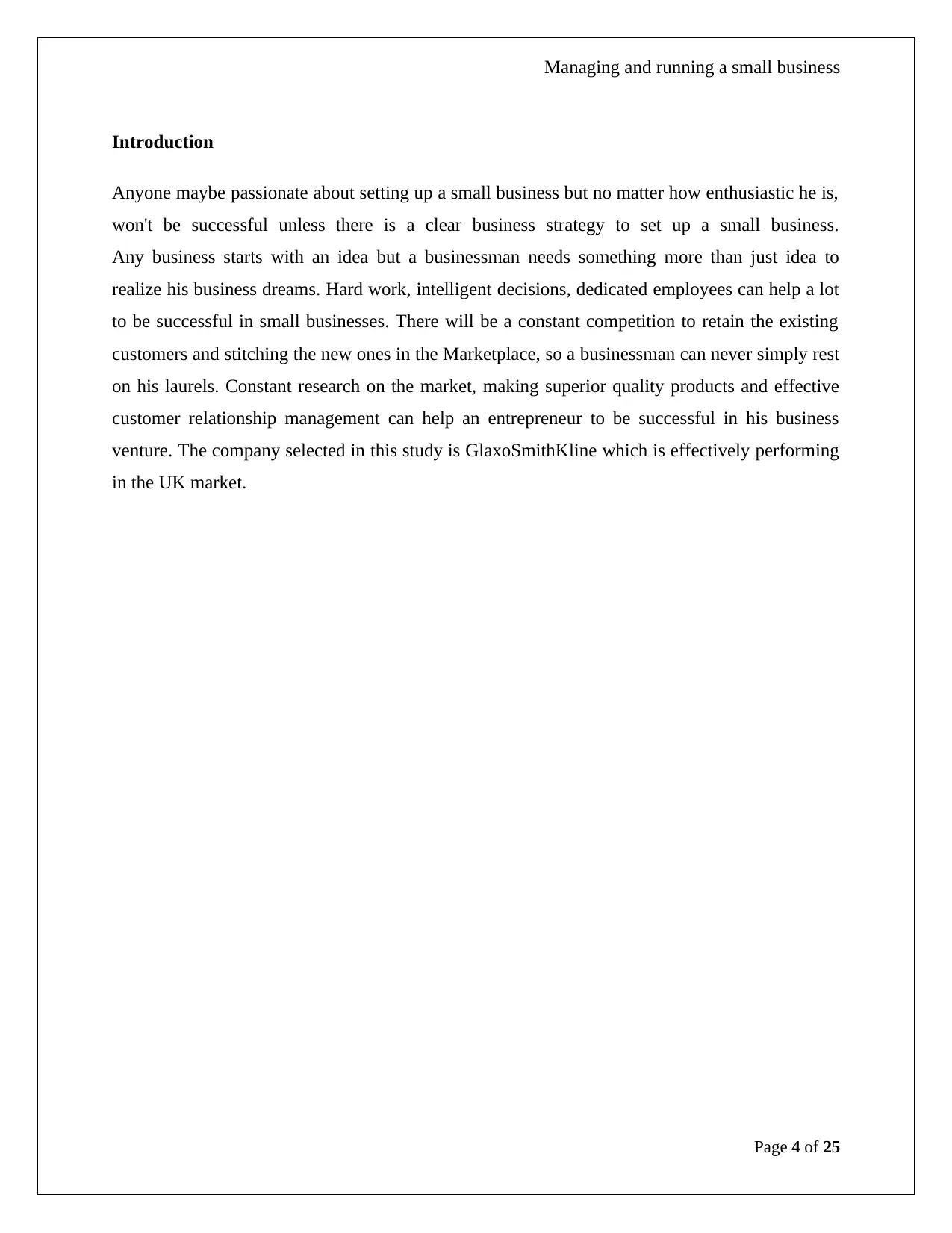
Managing and running a small business
Introduction
Anyone maybe passionate about setting up a small business but no matter how enthusiastic he is,
won't be successful unless there is a clear business strategy to set up a small business.
Any business starts with an idea but a businessman needs something more than just idea to
realize his business dreams. Hard work, intelligent decisions, dedicated employees can help a lot
to be successful in small businesses. There will be a constant competition to retain the existing
customers and stitching the new ones in the Marketplace, so a businessman can never simply rest
on his laurels. Constant research on the market, making superior quality products and effective
customer relationship management can help an entrepreneur to be successful in his business
venture. The company selected in this study is GlaxoSmithKline which is effectively performing
in the UK market.
Page 4 of 25
Introduction
Anyone maybe passionate about setting up a small business but no matter how enthusiastic he is,
won't be successful unless there is a clear business strategy to set up a small business.
Any business starts with an idea but a businessman needs something more than just idea to
realize his business dreams. Hard work, intelligent decisions, dedicated employees can help a lot
to be successful in small businesses. There will be a constant competition to retain the existing
customers and stitching the new ones in the Marketplace, so a businessman can never simply rest
on his laurels. Constant research on the market, making superior quality products and effective
customer relationship management can help an entrepreneur to be successful in his business
venture. The company selected in this study is GlaxoSmithKline which is effectively performing
in the UK market.
Page 4 of 25
Paraphrase This Document
Need a fresh take? Get an instant paraphrase of this document with our AI Paraphraser
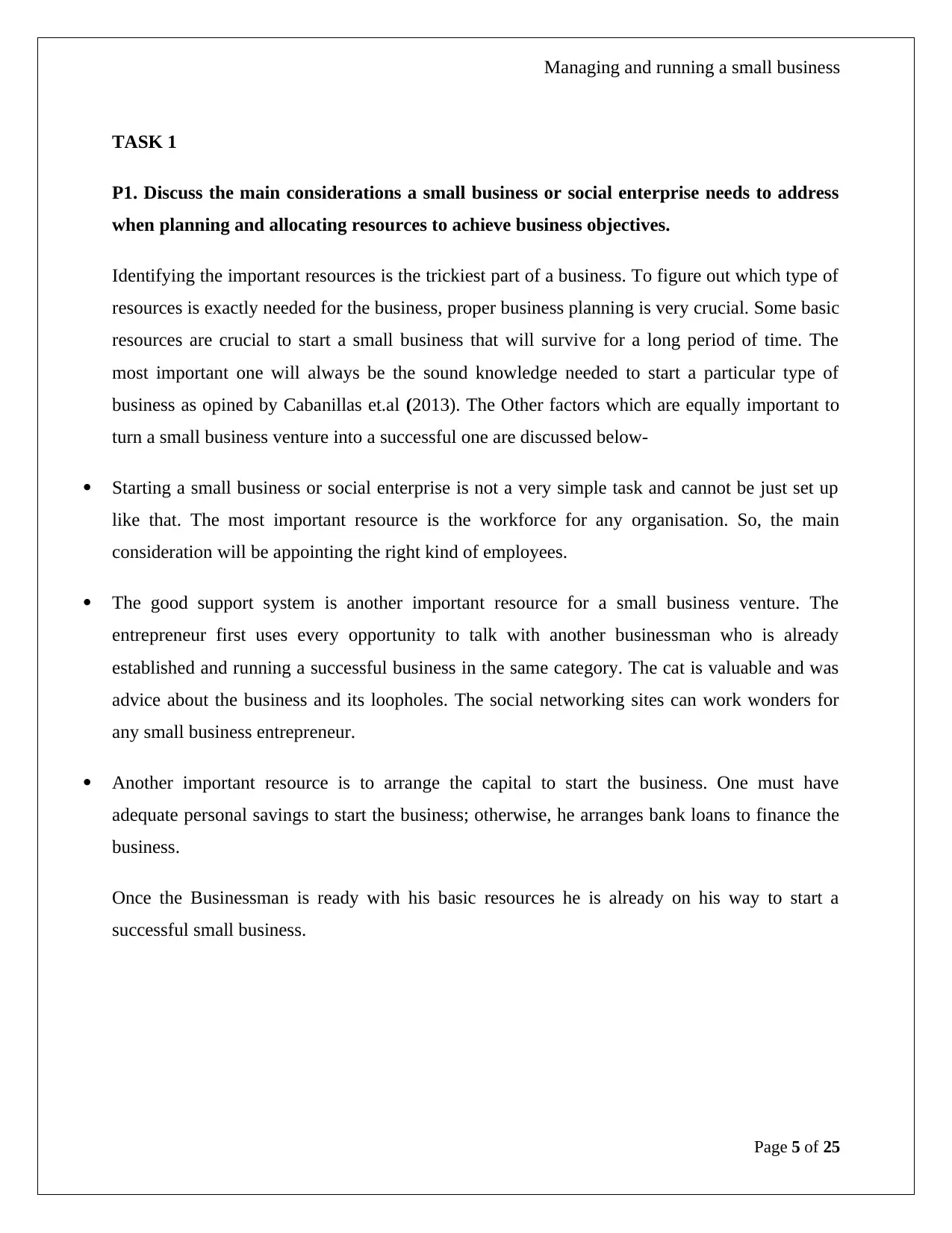
Managing and running a small business
TASK 1
P1. Discuss the main considerations a small business or social enterprise needs to address
when planning and allocating resources to achieve business objectives.
Identifying the important resources is the trickiest part of a business. To figure out which type of
resources is exactly needed for the business, proper business planning is very crucial. Some basic
resources are crucial to start a small business that will survive for a long period of time. The
most important one will always be the sound knowledge needed to start a particular type of
business as opined by Cabanillas et.al (2013). The Other factors which are equally important to
turn a small business venture into a successful one are discussed below-
Starting a small business or social enterprise is not a very simple task and cannot be just set up
like that. The most important resource is the workforce for any organisation. So, the main
consideration will be appointing the right kind of employees.
The good support system is another important resource for a small business venture. The
entrepreneur first uses every opportunity to talk with another businessman who is already
established and running a successful business in the same category. The cat is valuable and was
advice about the business and its loopholes. The social networking sites can work wonders for
any small business entrepreneur.
Another important resource is to arrange the capital to start the business. One must have
adequate personal savings to start the business; otherwise, he arranges bank loans to finance the
business.
Once the Businessman is ready with his basic resources he is already on his way to start a
successful small business.
Page 5 of 25
TASK 1
P1. Discuss the main considerations a small business or social enterprise needs to address
when planning and allocating resources to achieve business objectives.
Identifying the important resources is the trickiest part of a business. To figure out which type of
resources is exactly needed for the business, proper business planning is very crucial. Some basic
resources are crucial to start a small business that will survive for a long period of time. The
most important one will always be the sound knowledge needed to start a particular type of
business as opined by Cabanillas et.al (2013). The Other factors which are equally important to
turn a small business venture into a successful one are discussed below-
Starting a small business or social enterprise is not a very simple task and cannot be just set up
like that. The most important resource is the workforce for any organisation. So, the main
consideration will be appointing the right kind of employees.
The good support system is another important resource for a small business venture. The
entrepreneur first uses every opportunity to talk with another businessman who is already
established and running a successful business in the same category. The cat is valuable and was
advice about the business and its loopholes. The social networking sites can work wonders for
any small business entrepreneur.
Another important resource is to arrange the capital to start the business. One must have
adequate personal savings to start the business; otherwise, he arranges bank loans to finance the
business.
Once the Businessman is ready with his basic resources he is already on his way to start a
successful small business.
Page 5 of 25
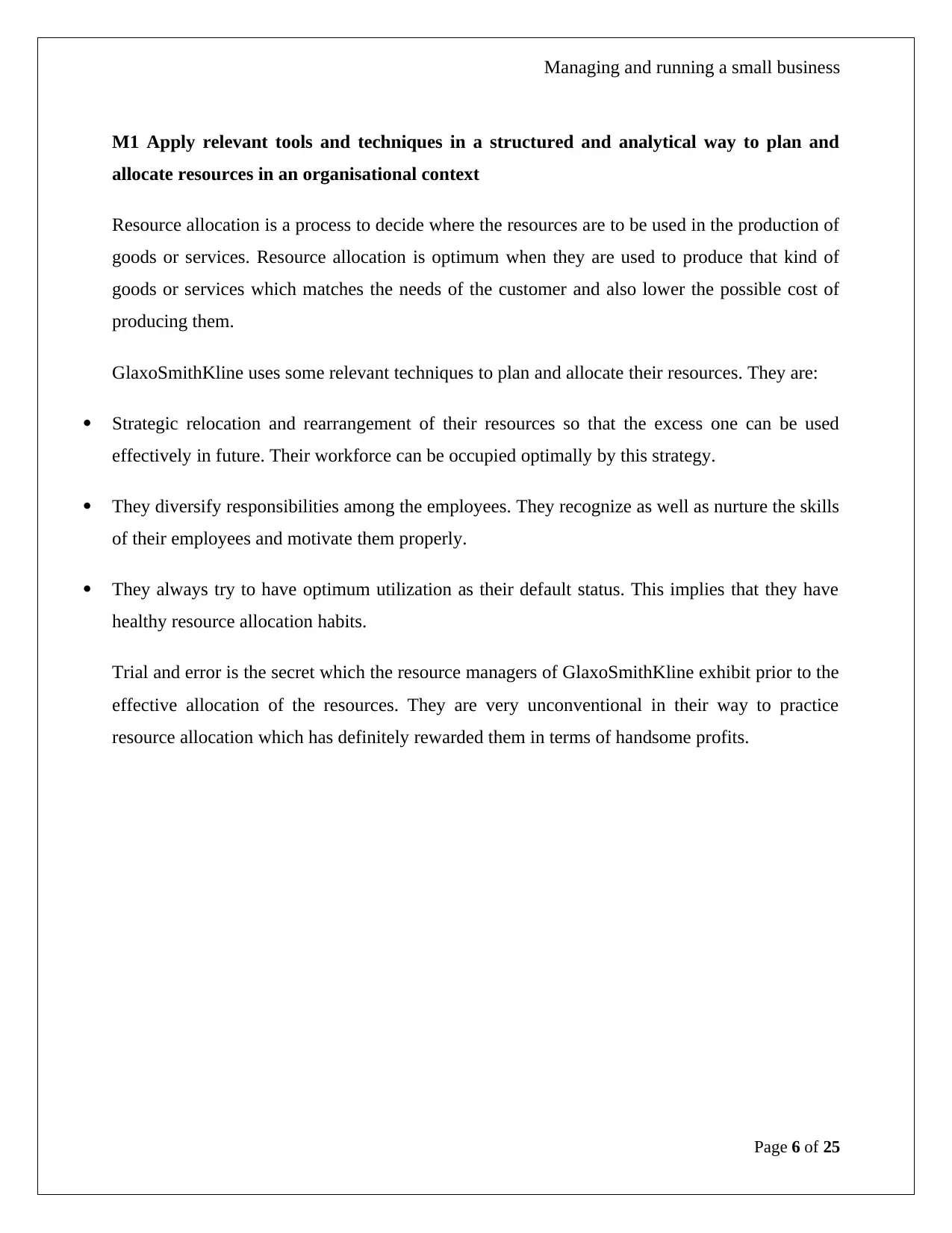
Managing and running a small business
M1 Apply relevant tools and techniques in a structured and analytical way to plan and
allocate resources in an organisational context
Resource allocation is a process to decide where the resources are to be used in the production of
goods or services. Resource allocation is optimum when they are used to produce that kind of
goods or services which matches the needs of the customer and also lower the possible cost of
producing them.
GlaxoSmithKline uses some relevant techniques to plan and allocate their resources. They are:
Strategic relocation and rearrangement of their resources so that the excess one can be used
effectively in future. Their workforce can be occupied optimally by this strategy.
They diversify responsibilities among the employees. They recognize as well as nurture the skills
of their employees and motivate them properly.
They always try to have optimum utilization as their default status. This implies that they have
healthy resource allocation habits.
Trial and error is the secret which the resource managers of GlaxoSmithKline exhibit prior to the
effective allocation of the resources. They are very unconventional in their way to practice
resource allocation which has definitely rewarded them in terms of handsome profits.
Page 6 of 25
M1 Apply relevant tools and techniques in a structured and analytical way to plan and
allocate resources in an organisational context
Resource allocation is a process to decide where the resources are to be used in the production of
goods or services. Resource allocation is optimum when they are used to produce that kind of
goods or services which matches the needs of the customer and also lower the possible cost of
producing them.
GlaxoSmithKline uses some relevant techniques to plan and allocate their resources. They are:
Strategic relocation and rearrangement of their resources so that the excess one can be used
effectively in future. Their workforce can be occupied optimally by this strategy.
They diversify responsibilities among the employees. They recognize as well as nurture the skills
of their employees and motivate them properly.
They always try to have optimum utilization as their default status. This implies that they have
healthy resource allocation habits.
Trial and error is the secret which the resource managers of GlaxoSmithKline exhibit prior to the
effective allocation of the resources. They are very unconventional in their way to practice
resource allocation which has definitely rewarded them in terms of handsome profits.
Page 6 of 25
⊘ This is a preview!⊘
Do you want full access?
Subscribe today to unlock all pages.

Trusted by 1+ million students worldwide
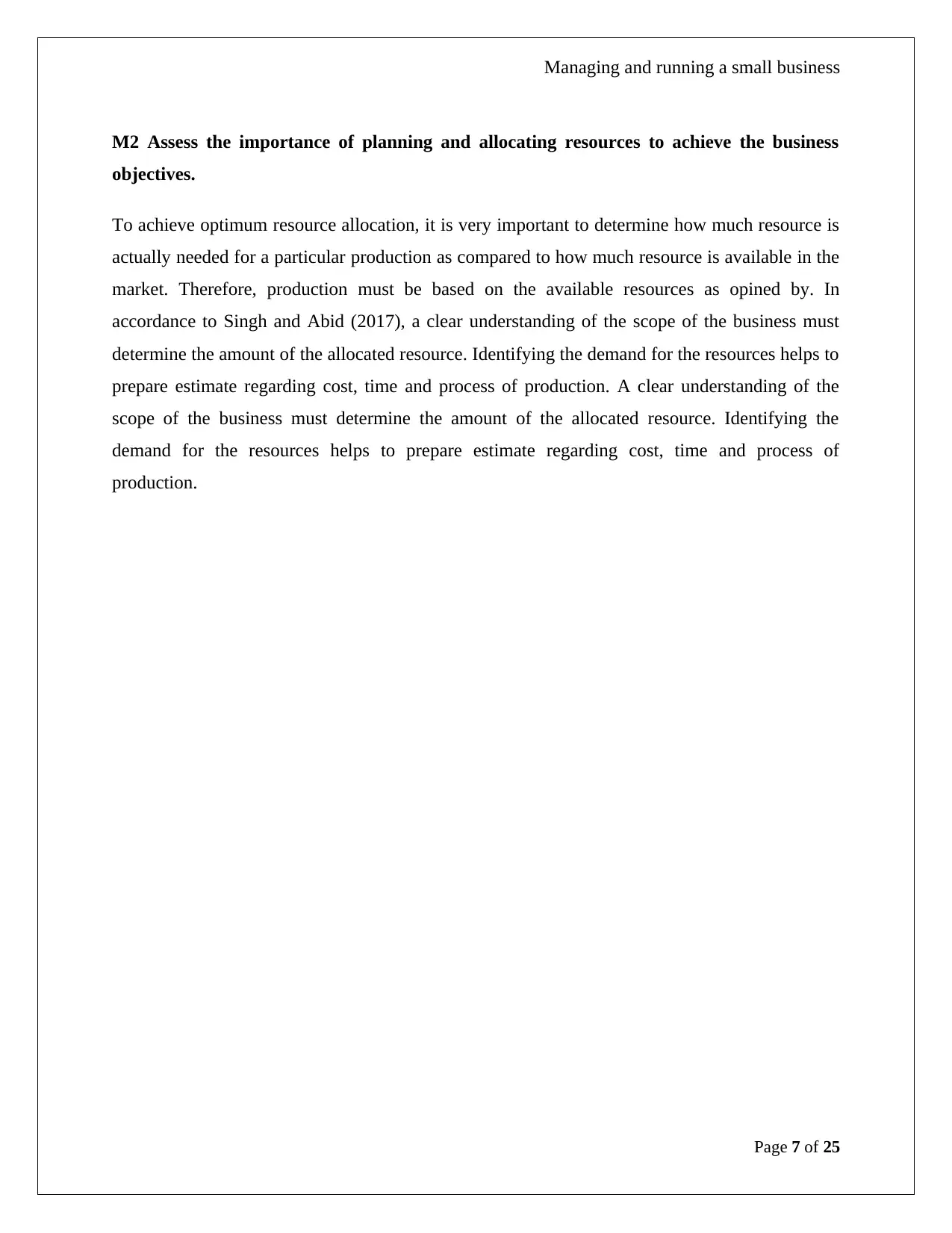
Managing and running a small business
M2 Assess the importance of planning and allocating resources to achieve the business
objectives.
To achieve optimum resource allocation, it is very important to determine how much resource is
actually needed for a particular production as compared to how much resource is available in the
market. Therefore, production must be based on the available resources as opined by. In
accordance to Singh and Abid (2017), a clear understanding of the scope of the business must
determine the amount of the allocated resource. Identifying the demand for the resources helps to
prepare estimate regarding cost, time and process of production. A clear understanding of the
scope of the business must determine the amount of the allocated resource. Identifying the
demand for the resources helps to prepare estimate regarding cost, time and process of
production.
Page 7 of 25
M2 Assess the importance of planning and allocating resources to achieve the business
objectives.
To achieve optimum resource allocation, it is very important to determine how much resource is
actually needed for a particular production as compared to how much resource is available in the
market. Therefore, production must be based on the available resources as opined by. In
accordance to Singh and Abid (2017), a clear understanding of the scope of the business must
determine the amount of the allocated resource. Identifying the demand for the resources helps to
prepare estimate regarding cost, time and process of production. A clear understanding of the
scope of the business must determine the amount of the allocated resource. Identifying the
demand for the resources helps to prepare estimate regarding cost, time and process of
production.
Page 7 of 25
Paraphrase This Document
Need a fresh take? Get an instant paraphrase of this document with our AI Paraphraser
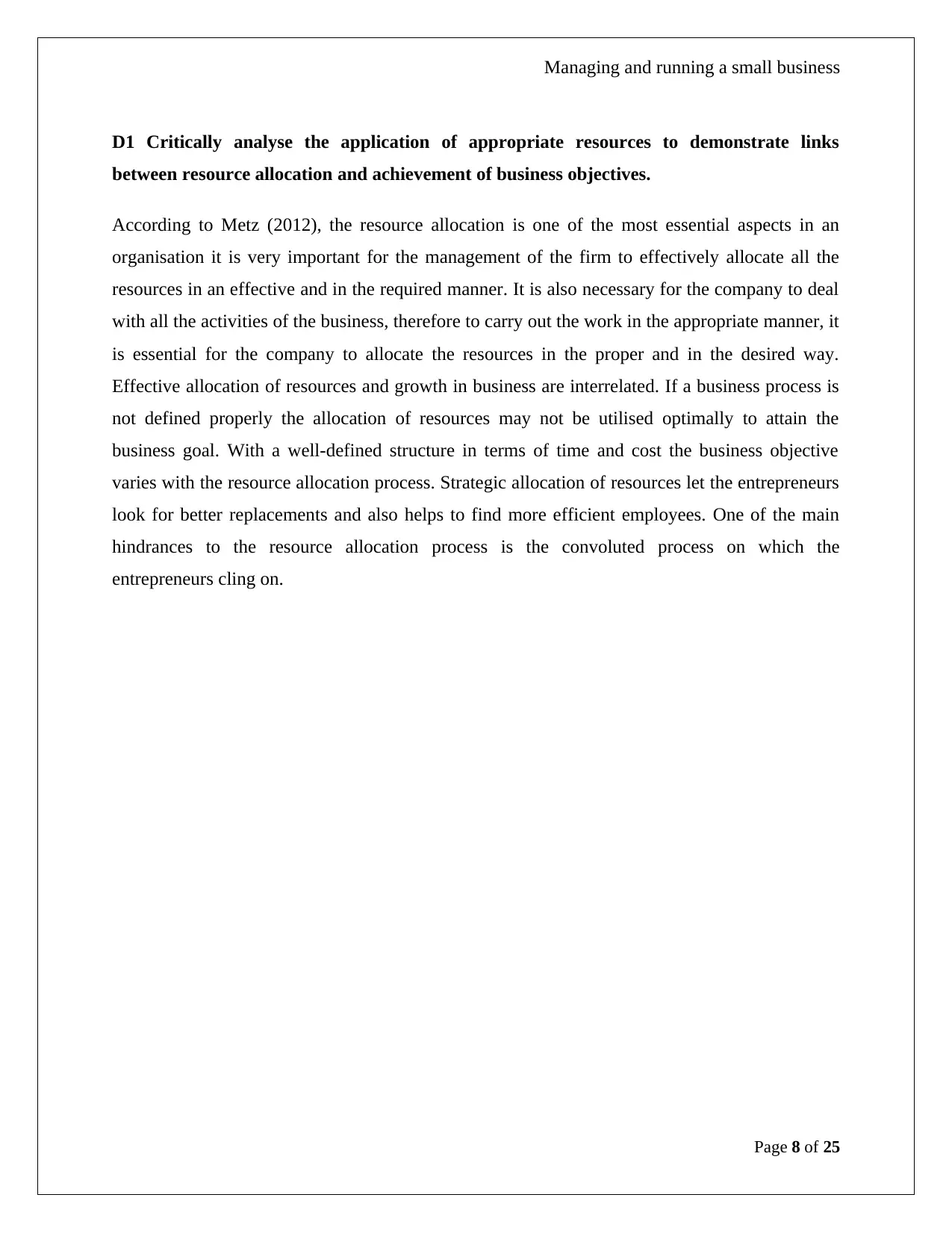
Managing and running a small business
D1 Critically analyse the application of appropriate resources to demonstrate links
between resource allocation and achievement of business objectives.
According to Metz (2012), the resource allocation is one of the most essential aspects in an
organisation it is very important for the management of the firm to effectively allocate all the
resources in an effective and in the required manner. It is also necessary for the company to deal
with all the activities of the business, therefore to carry out the work in the appropriate manner, it
is essential for the company to allocate the resources in the proper and in the desired way.
Effective allocation of resources and growth in business are interrelated. If a business process is
not defined properly the allocation of resources may not be utilised optimally to attain the
business goal. With a well-defined structure in terms of time and cost the business objective
varies with the resource allocation process. Strategic allocation of resources let the entrepreneurs
look for better replacements and also helps to find more efficient employees. One of the main
hindrances to the resource allocation process is the convoluted process on which the
entrepreneurs cling on.
Page 8 of 25
D1 Critically analyse the application of appropriate resources to demonstrate links
between resource allocation and achievement of business objectives.
According to Metz (2012), the resource allocation is one of the most essential aspects in an
organisation it is very important for the management of the firm to effectively allocate all the
resources in an effective and in the required manner. It is also necessary for the company to deal
with all the activities of the business, therefore to carry out the work in the appropriate manner, it
is essential for the company to allocate the resources in the proper and in the desired way.
Effective allocation of resources and growth in business are interrelated. If a business process is
not defined properly the allocation of resources may not be utilised optimally to attain the
business goal. With a well-defined structure in terms of time and cost the business objective
varies with the resource allocation process. Strategic allocation of resources let the entrepreneurs
look for better replacements and also helps to find more efficient employees. One of the main
hindrances to the resource allocation process is the convoluted process on which the
entrepreneurs cling on.
Page 8 of 25
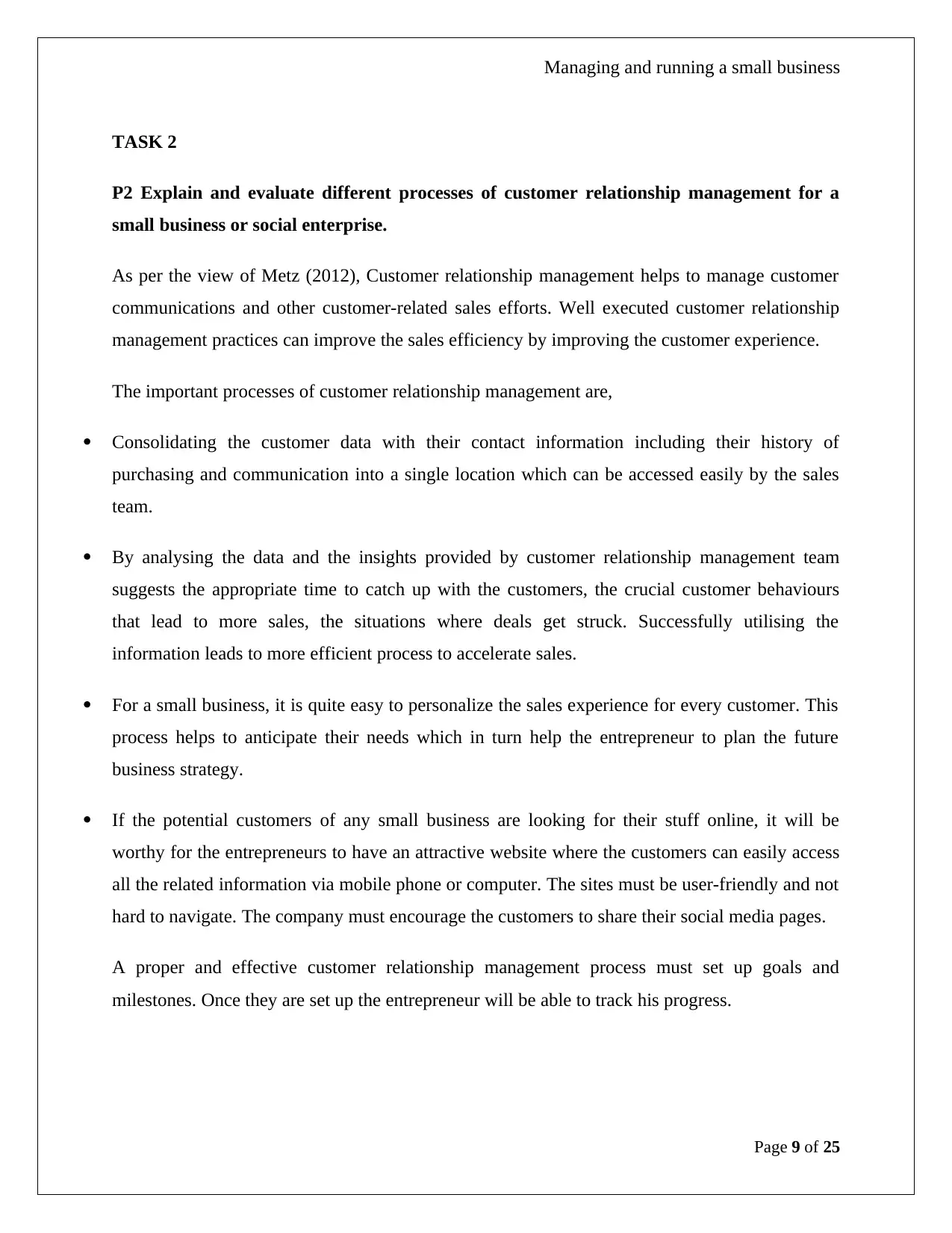
Managing and running a small business
TASK 2
P2 Explain and evaluate different processes of customer relationship management for a
small business or social enterprise.
As per the view of Metz (2012), Customer relationship management helps to manage customer
communications and other customer-related sales efforts. Well executed customer relationship
management practices can improve the sales efficiency by improving the customer experience.
The important processes of customer relationship management are,
Consolidating the customer data with their contact information including their history of
purchasing and communication into a single location which can be accessed easily by the sales
team.
By analysing the data and the insights provided by customer relationship management team
suggests the appropriate time to catch up with the customers, the crucial customer behaviours
that lead to more sales, the situations where deals get struck. Successfully utilising the
information leads to more efficient process to accelerate sales.
For a small business, it is quite easy to personalize the sales experience for every customer. This
process helps to anticipate their needs which in turn help the entrepreneur to plan the future
business strategy.
If the potential customers of any small business are looking for their stuff online, it will be
worthy for the entrepreneurs to have an attractive website where the customers can easily access
all the related information via mobile phone or computer. The sites must be user-friendly and not
hard to navigate. The company must encourage the customers to share their social media pages.
A proper and effective customer relationship management process must set up goals and
milestones. Once they are set up the entrepreneur will be able to track his progress.
Page 9 of 25
TASK 2
P2 Explain and evaluate different processes of customer relationship management for a
small business or social enterprise.
As per the view of Metz (2012), Customer relationship management helps to manage customer
communications and other customer-related sales efforts. Well executed customer relationship
management practices can improve the sales efficiency by improving the customer experience.
The important processes of customer relationship management are,
Consolidating the customer data with their contact information including their history of
purchasing and communication into a single location which can be accessed easily by the sales
team.
By analysing the data and the insights provided by customer relationship management team
suggests the appropriate time to catch up with the customers, the crucial customer behaviours
that lead to more sales, the situations where deals get struck. Successfully utilising the
information leads to more efficient process to accelerate sales.
For a small business, it is quite easy to personalize the sales experience for every customer. This
process helps to anticipate their needs which in turn help the entrepreneur to plan the future
business strategy.
If the potential customers of any small business are looking for their stuff online, it will be
worthy for the entrepreneurs to have an attractive website where the customers can easily access
all the related information via mobile phone or computer. The sites must be user-friendly and not
hard to navigate. The company must encourage the customers to share their social media pages.
A proper and effective customer relationship management process must set up goals and
milestones. Once they are set up the entrepreneur will be able to track his progress.
Page 9 of 25
⊘ This is a preview!⊘
Do you want full access?
Subscribe today to unlock all pages.

Trusted by 1+ million students worldwide
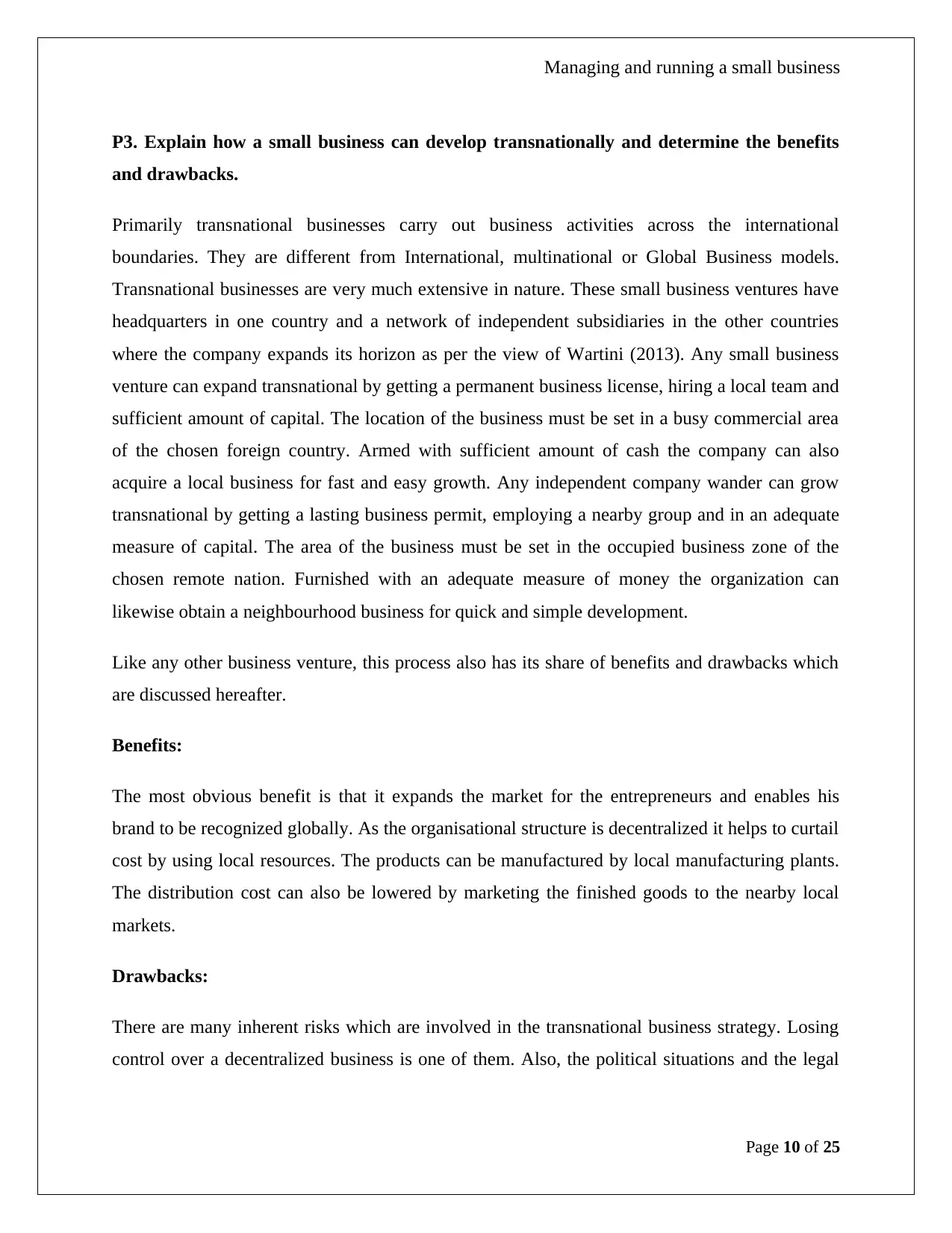
Managing and running a small business
P3. Explain how a small business can develop transnationally and determine the benefits
and drawbacks.
Primarily transnational businesses carry out business activities across the international
boundaries. They are different from International, multinational or Global Business models.
Transnational businesses are very much extensive in nature. These small business ventures have
headquarters in one country and a network of independent subsidiaries in the other countries
where the company expands its horizon as per the view of Wartini (2013). Any small business
venture can expand transnational by getting a permanent business license, hiring a local team and
sufficient amount of capital. The location of the business must be set in a busy commercial area
of the chosen foreign country. Armed with sufficient amount of cash the company can also
acquire a local business for fast and easy growth. Any independent company wander can grow
transnational by getting a lasting business permit, employing a nearby group and in an adequate
measure of capital. The area of the business must be set in the occupied business zone of the
chosen remote nation. Furnished with an adequate measure of money the organization can
likewise obtain a neighbourhood business for quick and simple development.
Like any other business venture, this process also has its share of benefits and drawbacks which
are discussed hereafter.
Benefits:
The most obvious benefit is that it expands the market for the entrepreneurs and enables his
brand to be recognized globally. As the organisational structure is decentralized it helps to curtail
cost by using local resources. The products can be manufactured by local manufacturing plants.
The distribution cost can also be lowered by marketing the finished goods to the nearby local
markets.
Drawbacks:
There are many inherent risks which are involved in the transnational business strategy. Losing
control over a decentralized business is one of them. Also, the political situations and the legal
Page 10 of 25
P3. Explain how a small business can develop transnationally and determine the benefits
and drawbacks.
Primarily transnational businesses carry out business activities across the international
boundaries. They are different from International, multinational or Global Business models.
Transnational businesses are very much extensive in nature. These small business ventures have
headquarters in one country and a network of independent subsidiaries in the other countries
where the company expands its horizon as per the view of Wartini (2013). Any small business
venture can expand transnational by getting a permanent business license, hiring a local team and
sufficient amount of capital. The location of the business must be set in a busy commercial area
of the chosen foreign country. Armed with sufficient amount of cash the company can also
acquire a local business for fast and easy growth. Any independent company wander can grow
transnational by getting a lasting business permit, employing a nearby group and in an adequate
measure of capital. The area of the business must be set in the occupied business zone of the
chosen remote nation. Furnished with an adequate measure of money the organization can
likewise obtain a neighbourhood business for quick and simple development.
Like any other business venture, this process also has its share of benefits and drawbacks which
are discussed hereafter.
Benefits:
The most obvious benefit is that it expands the market for the entrepreneurs and enables his
brand to be recognized globally. As the organisational structure is decentralized it helps to curtail
cost by using local resources. The products can be manufactured by local manufacturing plants.
The distribution cost can also be lowered by marketing the finished goods to the nearby local
markets.
Drawbacks:
There are many inherent risks which are involved in the transnational business strategy. Losing
control over a decentralized business is one of them. Also, the political situations and the legal
Page 10 of 25
Paraphrase This Document
Need a fresh take? Get an instant paraphrase of this document with our AI Paraphraser
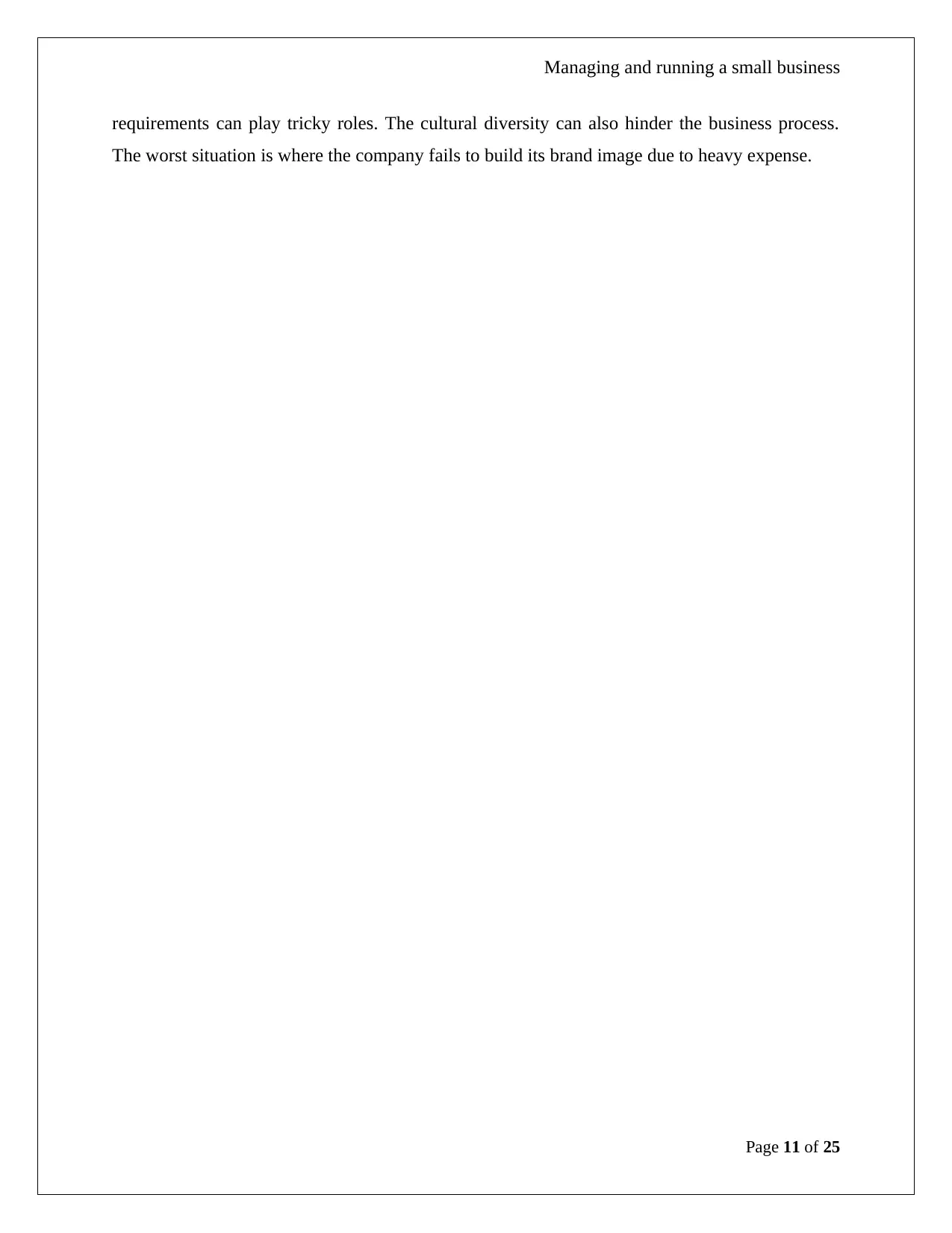
Managing and running a small business
requirements can play tricky roles. The cultural diversity can also hinder the business process.
The worst situation is where the company fails to build its brand image due to heavy expense.
Page 11 of 25
requirements can play tricky roles. The cultural diversity can also hinder the business process.
The worst situation is where the company fails to build its brand image due to heavy expense.
Page 11 of 25
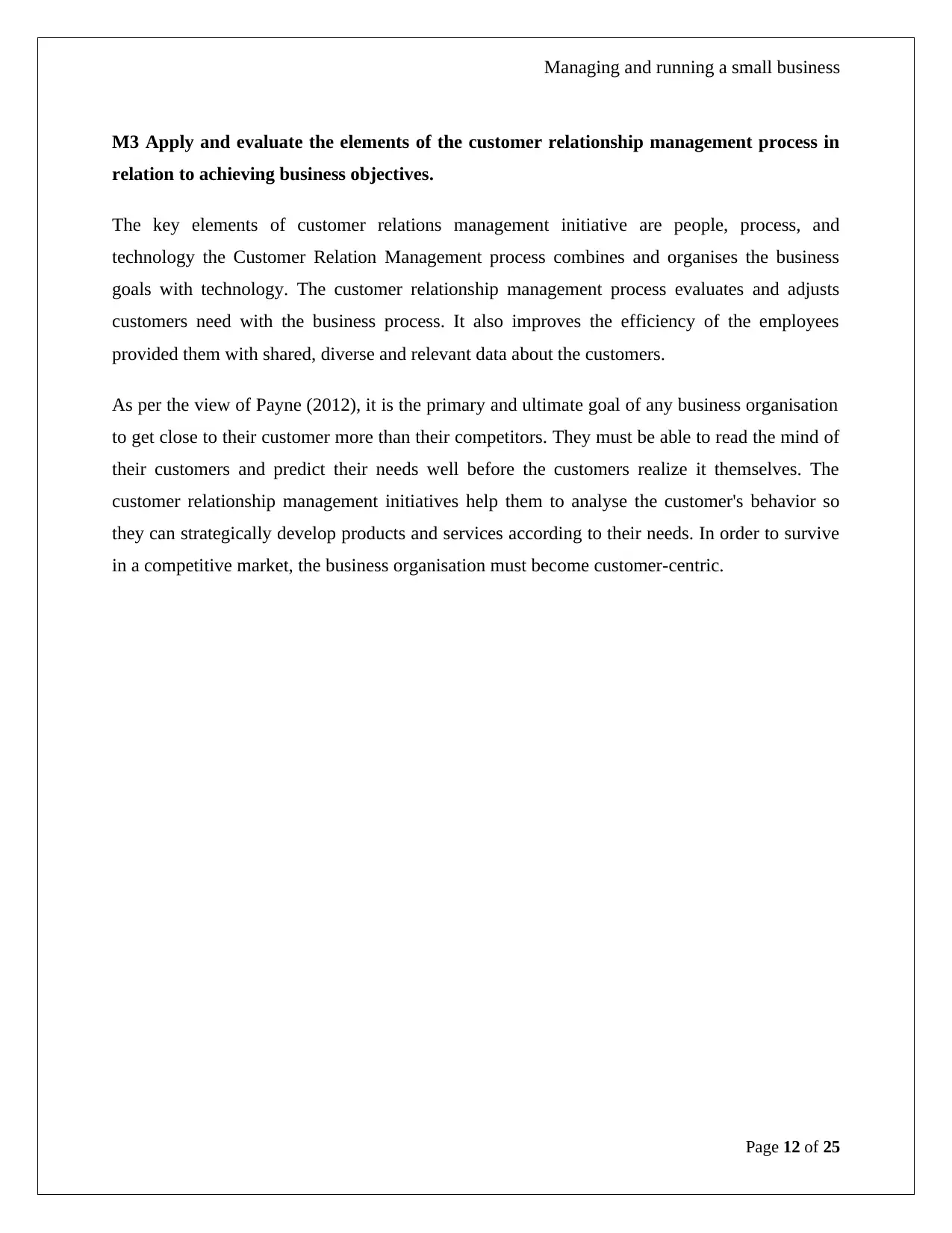
Managing and running a small business
M3 Apply and evaluate the elements of the customer relationship management process in
relation to achieving business objectives.
The key elements of customer relations management initiative are people, process, and
technology the Customer Relation Management process combines and organises the business
goals with technology. The customer relationship management process evaluates and adjusts
customers need with the business process. It also improves the efficiency of the employees
provided them with shared, diverse and relevant data about the customers.
As per the view of Payne (2012), it is the primary and ultimate goal of any business organisation
to get close to their customer more than their competitors. They must be able to read the mind of
their customers and predict their needs well before the customers realize it themselves. The
customer relationship management initiatives help them to analyse the customer's behavior so
they can strategically develop products and services according to their needs. In order to survive
in a competitive market, the business organisation must become customer-centric.
Page 12 of 25
M3 Apply and evaluate the elements of the customer relationship management process in
relation to achieving business objectives.
The key elements of customer relations management initiative are people, process, and
technology the Customer Relation Management process combines and organises the business
goals with technology. The customer relationship management process evaluates and adjusts
customers need with the business process. It also improves the efficiency of the employees
provided them with shared, diverse and relevant data about the customers.
As per the view of Payne (2012), it is the primary and ultimate goal of any business organisation
to get close to their customer more than their competitors. They must be able to read the mind of
their customers and predict their needs well before the customers realize it themselves. The
customer relationship management initiatives help them to analyse the customer's behavior so
they can strategically develop products and services according to their needs. In order to survive
in a competitive market, the business organisation must become customer-centric.
Page 12 of 25
⊘ This is a preview!⊘
Do you want full access?
Subscribe today to unlock all pages.

Trusted by 1+ million students worldwide
1 out of 25
Related Documents
Your All-in-One AI-Powered Toolkit for Academic Success.
+13062052269
info@desklib.com
Available 24*7 on WhatsApp / Email
![[object Object]](/_next/static/media/star-bottom.7253800d.svg)
Unlock your academic potential
Copyright © 2020–2025 A2Z Services. All Rights Reserved. Developed and managed by ZUCOL.





